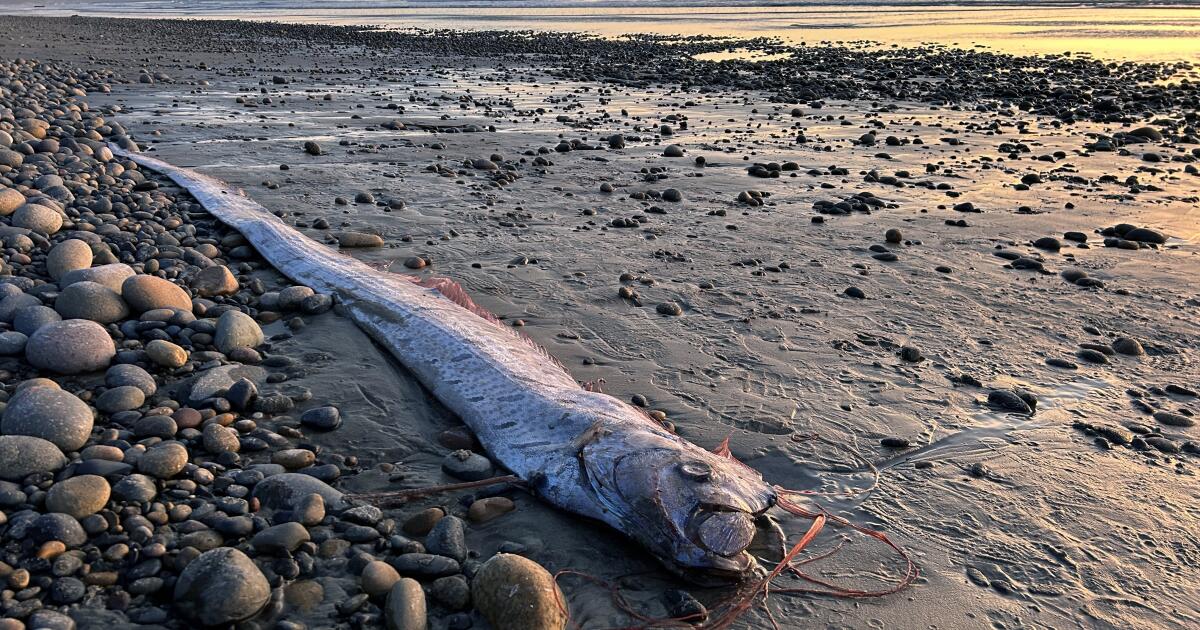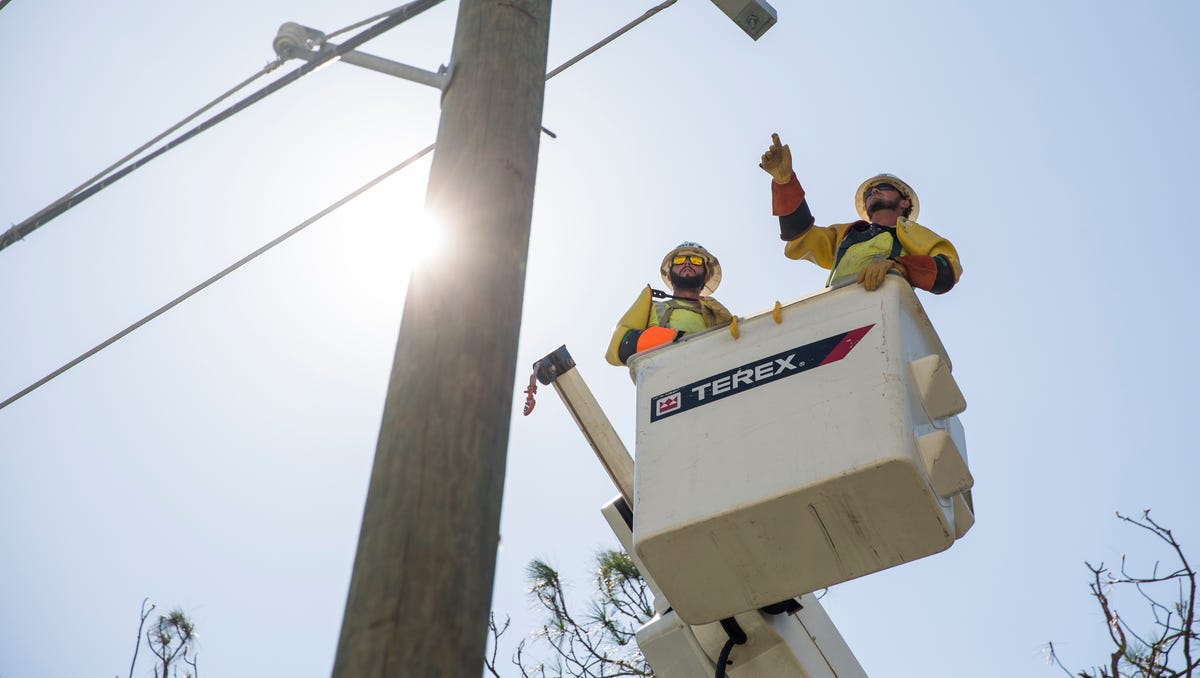California
‘I’m going to die’: One man’s horrific ordeal in the California mountains

After being pulled out from under the boulder, Kevin DePaolo was hoisted off the mountain by a U.S. Navy helicopter that came within 30 feet of the rocky terrain to retrieve him.
Inyo County Search & RescueWaves of sickening pain had turned Kevin DePaolo almost rabid as he lay pinned, bloodied and broken, beneath a five-ton granite boulder on the slope of a remote mountainside.
What was supposed to be a relaxing day of mineral hunting with a friend in the rugged backcountry of the Inyo Mountains in eastern California earlier this month quickly became a nightmarish fight for survival.
DePaolo had been digging in the dirt in the boulder’s shadow when the huge thing suddenly dislodged and toppled over, crushing the young man’s legs before coming to uncertain rest, teetering on his pelvis.
Advertisement
Article continues below this ad
Pinned on his back, head downhill in the dirt, DePaolo faced up the mass of the rock and shrieked in agony as gravity threatened to pull the stone over onto his chest and skull. Thinking quickly, his friend, Joshua Nelson, dug the head of a pickaxe into the dirt and jammed its handle under the looming edge of the rock to brace it in place. Then he dialed 911.
“The weight of the boulder has split his groin wide open,” Nelson said. “If it had rolled any more it would have crushed him to death.”
At one point, through dizzying pain, DePaolo, a 26-year-old rock climber and mountaineer, stared up at the blue December sky and wondered whether he’d make it out from under the rock alive.
“I thought, this is the most stupid tragedy to happen on such a beautiful day,” he said later. “Of all the dangerous stuff I do, I’m going to get crushed by a boulder? That’s ridiculous.”
DePaolo couldn’t have grasped in those early moments how first responders in the valley below would come up with one of the most creative rescues in the history of Inyo County — involving more than 12 ground responders, a U.S. Navy extraction team, a daring nighttime helicopter hoist, and a 30-pound car jack humped into the backcountry by an eccentric Australian auto mechanic.
Advertisement
Article continues below this ad
The high-desert outpost of Bishop rests in the dusty flats of Owens Valley, snug between the Southern Sierra’s sawtoothing spires and the crumbly ridges of the Inyo Mountains to the east.
The area is a hotspot of geologic activity and outdoor recreation — the gateway to Mt. Whitney, the state’s highest point, as well as a launchpad for Eastern Sierra peak baggers and a popular stopover for Pacific Crest Trail thru-hikers.
Noticeable to any visitor is the prevalence of huge boulders scattered about the valley floor. These house- and bus-sized chunks of granite tumbled out of the slopes eons ago, and many serve as standalone play objects for rock climbers and offroaders.
DePaolo, a mountain lover from New York with long blond hair and wide smile, arrived in town in early December to reconnect with Nelson, his climbing mentor and a Bishop local, and unwind in his favorite setting in the Lower 48. For the past three years, he’s been road tripping across the American West and living out of his van, bagging peaks in Washington and Alaska before heading south to Bishop.
Advertisement
Article continues below this ad
Kevin DePaolo is an avid peak bagger who had been traveling to mountain ranges across the West before his freak accident getting pinned under a boulder in Inyo County.
Courtesy Kevin DePaoloNeither man was feeling up for a tough day when they met on the morning of Dec. 5. DePaolo had recently summited the 13,658-foot Mt. Tom and Nelson was fighting off an illness and nursing back pain. So they opted for a casual backcountry outing to search for stones.
The mountains there keep deposits of quartz, garnets, obsidian and other gemstones and were once favored by prospectors and mining interests. Nelson and other locals have made rock-hounding on public lands a hobby, and it’s one that can reward those willing to hike long distances into remote areas.
“The idea was to use the day as downtime to do something less dangerous, something super calm,” DePaolo said. “It’s good for your mind and relaxing to go hunt for rocks.”
Advertisement
Article continues below this ad
The men settled on a spot 90 minutes southeast of town in the Inyo Mountains, a treeless landscape dotted with standing stones.
Nelson scooped up DePaolo in his SUV with the tools they’d need: pick-axes, shovels, chisels, pry bars and rock hammers.The two drove a dirt road to the base of a high ridgeline, parked and loaded up about 70 pounds of gear between them. Each brought water, lunch, snacks and phones. Nelson brought extra food, spare headlamp batteries and warm layers.
“I don’t walk a quarter of a mile into the mountains without bringing stuff to maybe spend the night,” Nelson said. “It could get windy, it could get cold, you could be there at night. You gotta be prepared out there because you never know.”
At 10:30 a.m., under a cloudless blue sky, they shouldered their packs and set out up a slope of loose scree, without a trail to guide them, scraping past sagebrush. It was quiet and cool, with little wind and no other humans or cars in sight. “It was the most beautiful day ever,” Nelson said.
Ninety tough minutes later they’d scrambled up a pair of gullies to a steep expanse pocked with refrigerator-sized boulders. Across the valley was the Southern Sierra’s sawtooth skyline, dusted with snow. They dropped their packs and began scouring the dirt for minerals.
Advertisement
Article continues below this ad
Eventually they uncovered a seam of quartz and chased it to the base of two oblong boulders the size of washing machines dug into the slope. Pick in hand, DePaolo laid down on all fours and scratched excitedly at a mud hole below one boulder. As he sat up to take a break, the large rock did something strange — it wobbled forward.
“Kev look out!” Nelson yelled. But DePaolo couldn’t clear the boulder’s path.
“The next thing I know I took the hit. It felt like a bus crashing into my left leg and my pelvis and it just pile-drived into my body and ripped me apart,” DePaolo said.
Nelson heard his friend scream and dashed down to help him. Both of DePaolo’s legs were pinned under the giant rock, its full weight crushing his groin. Nelson wedged an ax handle under the boulder to prevent it from toppling completely onto DePaolo’s chest. Then he squatted down, grabbed hold of its underside and strained to lift.
Somehow, Nelson was able to pry the boulder up enough for DePaolo’s left leg to slide free. It came out blackened with bruising and split open at the groin. Nelson saw blood, bone, strands of muscle and tendon. DePaolo’s right leg remained trapped under the rock.
“Instantly, I knew we went from zero to one hundred and this was a serious situation,” Nelson said. “I didn’t know the extent of his injuries but I knew we weren’t hiking out of there.”
Nelson tied a shirt around DePaolo’s exposed leg to stymie the bleeding then pulled out his phone and dialed. DePaolo screamed into the thin mountain air.
The emergency call reached the Inyo County Sheriff’s Office just after 3 p.m. An official there raised the local search-and-rescue team, a volunteer crew of about 60 members with an astonishing range of wilderness experience and technical skills.
Among the crew are physicians and teachers; one is an Aussie mechanic who specializes in extracting offroad vehicles stuck on rock trails. Most members are hardened mountain climbers with expertise in wilderness medicine, rope access and high-angle rescue. They’re one of the busiest SAR teams in the state, according to the Inyo County Sheriff’s Cpl. Nate Girardin, the team’s co-coordinator. They’re deployed to between 60 and 100 missions per year, the bulk of which involve helping injured or lost climbers off of Mt. Whitney.
As searchers mobilized, Sheriff’s officials called the California Highway Patrol in Fresno for helicopter assistance. The plan was to airlift two SAR members with medical training to the mountain so they could triage DePaolo’s injuries as soon as possible. At the same time, two more searchers would drive to the backside of the mountain where DePaolo was trapped, with the intent to hike over to him and figure out a way to free him.
A California Highway Patrol helicopter airlifted a pair of rescuers to the mountain where Kevin DePaolo was trapped under a boulder.
Courtesy Inyo County Search and RescueBy the time the helicopter touched down outside of town, the sun had dropped below the Sierra crest, sucking the heat out of the valley. Nelson had helped cut away DePaolo’s cargo pants and wrapped his exposed left leg in puffy jackets, but the temperature was plummeting and DePaolo had begun to shiver violently on the ground. Nelson built a small fire and fed it with sagebrush to keep his friend warm.
DePaolo never drifted from wakefulness but would pendulum between periods of calm and outbursts of explosive panic. Nelson registered his friend’s extreme pain but had noticed that blood wasn’t pooling in the dirt around DePaolo’s lower body, a sign he took that his friend wasn’t at imminent risk of bleeding out.
At one point, overcome with dread, DePaolo pleaded with his friend to call his mother in New York so he could tell her goodbye.
“Please call my mom,” he told Nelson. “I need to tell her I’m going to die up here.”
Nelson thought for a moment then refused.
“As much as I definitely respected that, I felt at the time that calling his mom was going to stress Kev out and I didn’t want to bring emotion into this,” Nelson said. “It was a survival situation and you need to be as calm as you can possibly be.
“I told him, ‘You don’t need to say your goodbyes because you’re going to live’.”
By the time Nelson saw the headlamp beam coming downslope towards him, DePaolo was in his fifth hour under the boulder’s crushing weight. It was just after 7:00 p.m.
The first searchers to arrive were the two men who’d hiked from the backside of the mountain, about 45 minutes in the dark: the Aussie, who goes by Tim K., and Matt, an engineer and ropes expert. (The Inyo SAR members requested that only their first names be used to spare themselves public attention.) They marched into camp shouldering an unlikely tool that would prove critical in extracting the wounded hiker: a Hi-Lift jack.
The two-foot-long steel ratchet lift weighs 30 pounds and looks like a machine gun barrel. A long hand lever angling up from its base activates an iron claw that climbs up notches on its main shaft. It’s rated to lift, or winch, 5,000 pounds at about an inch per lever depression. Tim regularly uses it when called to dislodge Jeeps and rock crawlers that get stuck in the piles around Bishop. He’s even used it to move large boulders on 4×4 trails.
“I call it landscaping, as a joke,” Tim said.
When the search-and-rescue alert went out, Tim grabbed his jack and volunteered. “We didn’t know exactly what we were getting into but I figured it was something a jack could probably help with,” he said.
A critical piece of gear in the rescue of Kevin DePaolo was a Hi-Lift jack, used to lift the boulder on the hiker’s legs, estimated to weigh between 6,000 and 10,000 pounds.
Courtesy Inyo County Search and RescueTim and Matt were soon joined by two more SAR members airlifted via CHP helicopter to the top of a nearby ridge. One of them, Isaac, snapped on a pair of latex gloves and began triaging DePaolo. The other, a schoolteacher named Dan, unzipped a bag of gear he’d brought along, which included a cordless hammer drill capable of piercing granite, a set of steel bolt-anchors, four pulleys and a length of 11mm static rope.
Tim, Matt and Dan stood shoulder to shoulder and sized up the situation, roughing out some basic geometry on the spot. They estimated the boulder weighed between 6,000 and 10,000 pounds and was resting on a 35-degree slope. They resolved to build a simple rope apparatus that, aided by the jack, would create enough force to pull the boulder up and away from the injured hiker’s legs.
“We kinda looked at each other’s stuff and said, this’ll probably work,” Tim said.
Dan grabbed the power drill and drove two bolts into the boulder: one on the underside near DePaolo’s torso, the other atop its crown. Tim positioned his jack in the dirt near DePaolo and carabiner-clipped it to the low bolt. He’d do the prying, one slow inch at a time.
Inyo County Search and Rescue Team members get to work drilling bolts into the boulder atop Kevin DePaolo before rigging a rope apparatus to haul it off of him.
Courtesy Inyo County Search and RescueDan and Matt then traversed the mountainside to an enormous granite stone 30 feet away and drilled two more bolts. Then they rigged a rope from the top bolt on DePaolo’s boulder to the massive anchor stone and fashioned it with pulleys and a special knot designed to multiply their exertion and create mechanical advantage.
The machine was set: When Tim cranked the jack, Dan and Matt would haul on the rope to pull the boulder sideways onto a makeshift foundation of melon-sized stones the men had placed on the ground next to DePaolo.
At about 8:10, Nelson and Isaac crouched down on either side of DePaolo and each grabbed an armpit, ready to pull.
“You ready to load up?” Tim called.
“Tension on the rope!” Dan yelled back.
Tim ratcheted the jack up a notch while the two rope haulers heaved, but DePaolo wouldn’t budge. Two notches: his leg was still caught.
On the jack’s third click, the men ripped DePaolo clear of the rock and laid him in the dirt. He shrieked in pain. Isaac knelt down to triage the left leg and groin.
“All I wanted was to get out from under that boulder,” DePaolo said. “But then as soon as they got me out, I was in agony.”
Inyo County Search and Rescue Team members confab about what to do after extracting Kevin DePaolo (center) from under the boulder that had been crushing his legs.
Joshua NelsonMore SAR members hiked in bearing supplies — sleeping bags, snacks, tea — to keep DePaolo comfortable. They gauzed up his wounds, fed him Tylenol and packaged him on a field litter. But as he lay screaming on the ground, no one was sure when they’d be able to get him off the mountain.
The CHP helicopter wasn’t cleared to perform a night extraction, and the message coming from officials in the valley below was that DePaolo would likely have to tough it out until first light, a disheartening prospect given his condition.
An urgent request from the Sheriff’s office broadcast through the state Office of Emergency Services reached the U.S. Navy’s air station in Lemoore, south of Fresno. At around 9:30, a four-man flight crew there loaded into a 65-foot tactical helicopter called a Sea Hawk and flew east over the Sierra.
Though the crew specializes in nighttime hoists, this one would be tricky.
The plan was to drop a crewman at the site, lift off while the man loaded DePaolo into a steel litter, then return to hoist them both up. They’d have to bring the bird close — within 30 feet of the rocky terrain — so rotor blade clearance would be tight against the steep mountainside. And there was concern that loose soil and rocks stirred up by the rotors could limit visibility or, worse, blast DePaolo or the SAR members on the ground with shrapnel.
“We knew if we deviated, we could potentially push survivors or the rescue team off the steep surface,” said Navy Lt. Shagore Paul, the SAR mission commander who piloted the helicopter.
“We had to be right on target,” said Lt. William Zell, the copilot.
Cruising over the dark, desolate valley, the pilots spotted the SAR team’s headlamp beams on the mountainside from five miles away. As the helicopter approached, the SAR members doused the campfire, slid a pair of sunglasses onto DePaolo to shield his eyes, then retreated uphill to stay clear, and watched.
About a dozen members of the Inyo County Search and Rescue Team responded to the site in the Inyo Mountains where Kevin DePaolo had become pinned under a boulder.
Courtesy Inyo County Search and RescueThe aircraft arrived deafeningly loud and blindingly bright, whipping up the air and dirt as it hovered over DePaolo. A crewman from above appeared on the ground next to the wounded man and the helicopter lifted off. As he took DePaolo’s vitals and loaded him into a steel litter, DePaolo remembers thinking, “This guy looks younger than me!”
The flight to the hospital in Fresno took 45 minutes. There, DePaolo was rushed from the helipad to the trauma unit and then into surgery to repair a ruptured femoral artery in his left leg. That’s when he finally called his mom and gave her the news — that he was in a terrible accident but that he’d be okay.
His pelvis is fractured in two places. He’ll need skin grafts on his blackened left leg, which took the brunt of the boulder’s impact before he and Nelson managed to pull it clear. But his right leg, which was trapped under the boulder, has nerve damage but is mostly fine, and DePaolo can sit upright. He will walk again — but possibly not for at least a few months.
A week after the incident, on a phone call from his hospital bed, DePaolo’s spirits were high. He said he was definitely re-evaluating his tolerance for risk, but also that he couldn’t wait to get into nature again. He’s got more peaks on his climbing list and plans to meet a buddy at the Grand Canyon — maybe next year.
Kevin DePaolo, recovering in Fresno’s Community Regional Medical Center.
Courtesy Kevin DePaoloHe attributes his good fortune to Nelson, who cared for him through the ordeal, and of course the devotion and resourcefulness of the Inyo SAR team.
“They were so professional, so calm,” he said. “Those dudes are a bunch of badass angels.”
Depaolo’s day with Nelson was supposed to be an easy excursion where he could reflect on a few recent close calls he’d had in the mountains.
“I’m just happy I get to keep living and keep walking and keep my legs,” he said. “It’s a miracle.”
Reach Gregory Thomas: gthomas@sfchronicle.com

California
'Doomsday fish' washed ashore in California, but what does that mean?

If one oarfish landing on a beach is a sign of a disaster to come, how bad will it be if three wash up in quick succession?
A silvery 10-foot-long creature, the oarfish has fueled fisherman’s tales of sea serpents — and in some cultures has been a portent of natural disasters.
It’s rare to see an oarfish up close in California; only 22 have washed ashore since 1901, according to UC San Diego’s Scripps Institution of Oceanography. But in the last three months, three of them have surfaced on Southern California beaches.
The latest was on Nov. 6, when an oarfish was discovered at Grandview Beach by Alison Laferriere, a doctoral candidate at Scripps Institution of Oceanography. The other two beached in La Jolla and Huntington Beach.
The last time a series of oarfish came ashore in California and other parts of the world was over several months in 2013 and 2014. Misty Paig-Tran, associate professor of biological science at Cal State Fullerton, studied four of them.
Every time an oarfish makes an appearance on the sand, it’s a spectacle for scientists as well as the general public for several reasons.
To start with, nobody is expecting a behemoth that’s up to 25 feet long to come so close to the California coast, said Paig-Tran.
“What’s special about them is that when they’re freshly dead or just about to die and you look at their skin, it actually [looks] like a mirror,” she said.
Its length combines with its silver skin and bright red scarlet fins to give it a mythical look.
Since the 1500s, sailors have told of sea monsters as long as their ships, and have even drafted maps that warned of areas in the ocean where such creatures resided. Their depictions appear to describe oarfish.
Oarfish generally live in the upper layers of the ocean depths, from about 300 feet to almost 3,000 feet underwater. Scientists call this section of the ocean the “twilight zone” because the fish that inhabit it are basically living in darkness with only a small glimpse of light, Paig-Tran said.
The twilight zone is too deep for divers to reach and explore, adding to the allure of this species.
If an oarfish happens to swim up to the ocean’s surface, a sailor would see a long slithering creature with spiky protrusions on its head and could believe it was a sea monster, Paig-Tran said.
It’s a jarring sight, but oarfish are anything but dangerous. Oarfish are bottom feeders, meaning they primarily feed on krill (a small shrimp-like creature) using powerful mouths shaped liked vacuum nozzles, according to Scripps.
An oarfish’s body is extremely delicate, so much so that if you pick one up it could break in half because of its jelly-like bones, Paig-Tran said.
Another factor that adds to the mystique of this creature is the lack of knowledge about its history and daily life, including how it mates, when it lays eggs, what its movement patterns are and how often it feeds.
Scientists are able to study the creatures only when they wash up on a beach.
“When a body comes up, we can do our best to look to the biology and the physiology and try to make our best guesses, but we don’t get to see it living in its natural environment,” Paig-Tran said. “It’s a completely open-ended question of what’s going on with these fishes.”
Why are dead oarfish washing ashore?
Scientists don’t know why these oarfish have died and washed ashore.
The latest oarfish spotted in Encinitas was recovered by a team of NOAA Fisheries Service and transported to Southwest Fisheries Science Center, where it will undergo an autopsy so researchers can learn more about the biology, anatomy, genomics and life history of oarfish, according to Scripps.
The deaths of the three fish that have surfaced “may have to do with changes in ocean conditions and increased numbers of oarfish off our coast,” said Ben Frable, manager of Scripps Oceanogaphy Marine Vertebrate Collection.
“Sometimes it may be linked to broader shifts, such as the El Niño and La Niña cycle, but this is not always the case,” he said.
There was a weak El Niño earlier this year, and this wash-up coincided with the recent red tide and Santa Ana winds last week. But many other factors could have played a role in these strandings, Frable added.
Another possible explanation is that the oarfish got stuck in a current and couldn’t go back down into deeper waters.
Oarfish aren’t strong swimmers. They primarily rely on their dorsal fin, whereas strong swimmers use their caudal fin or back tail, Paig-Tran said.
An oarfish that gets caught in a current and is taken up to the surface doesn’t have a good way to get back down.
“If you are a fish that lives in the deep and you got stuck on the surface, you’re kind of hosed,” she said.
Where did the “doomsday” name come from?
Oarfish have been dubbed “doomsday” fish because some cultures consider it a bad sign when they appear. The moniker is derived from a manipulation of Japanese folklore that became popular following the Fukushima disaster, Frable said.
“In the two years prior to the disaster, about a dozen oarfish washed up in Japan, most hundreds of miles away from this area.” he said.
In the aftermath of the natural disaster, people latched onto these strandings as an omen of the disaster.
This prompted researchers in Japan in 2019 to test whether oarfish and other deep-sea animal strandings were correlated with earthquakes, tsunamis and other factors.
“They found no correlation whatsoever,” Frable said. “But the name is too evocative to disappear.”
On the other hand, Paig-Tran said there could be some truth to the myth because when an earthquake happens, it releases pressure that can change a current underwater.
“When the pressure gets released, it changes the currents that [the fish are] living in, and it brings them up to the surface with this kind of big bolus of air and gasses and whatever the turbulence [is] from this earthquake,” she said.
So, are the oarfish that surfaced in Southern California a harbinger of a massive earthquake? According to Paig-Tran: probably not.
California
Trump wants even looser AI guardrails. How California could impose more

In summary
President-elect Trump has vowed to rescind an executive order that imposed AI safeguards, and could use tech to enable mass deportations. How far will California the other direction?
California Gov. Gavin Newsom is preparing to wage a legal war against President-elect Donald Trump, convening a special legislative session next month to try to “Trump-proof” the state. But it appears Newsom and California legislators won’t initially include artificial intelligence safeguards in that fight, even though AI regulations were a major preoccupation of the Legislature this year.
Trump has promised to immediately rescind President Joe Biden’s executive order that had imposed voluntary AI guardrails on tech companies and federal agencies. The president-elect’s administration could also, immigrant advocates say, use AI tools to assist the mass deportation he has pledged to implement.
While California adopted a number of AI regulations earlier this year, other issues are likely to take priority in Newsom’s special session, legislators told CalMatters.
There are signs, though, that AI could — in the not-so-distant future — go from abstract concern to prominent political cudgel between the Trump administration and California’s Democratic leaders. It could be another high-profile way to challenge Trump and his newfound tech allies, some of whom have gleefully proclaimed a new, deregulated era for artificial intelligence products.
“I think Newsom and the California Legislature have an opportunity to step into the gap that the federal government is leaving — to create a model environment for safe and rights-respecting technology and deployment,” said Janet Haven, executive director of the Data & Society Research Institute, a nonprofit that studies the social implications of AI and other technologies. “On the other hand, there’s no way to get around the fact that Big Tech is right there, and will be a huge factor in whatever the California Legislature and Newsom want to advance in terms of AI legislation.”
Why California lawmakers and others worry about AI
AI safety advocates told CalMatters they’re not necessarily sweating the apocalyptic AI nightmares imagined by some doomsayers. Instead, they are focused on how AI tools are increasingly used in healthcare, housing, the labor force, law enforcement, immigration, the military, as well as other industries and fields prone to discrimination, surveillance, and civil rights violations — because there’s evidence that such tools can be unwieldy, inaccurate, and invasive. “We have documentation that shows how these AI systems are likely to do all sorts of things—they’re pattern-making systems, they’re not really decision-makers, but the private sector and the public sector are using them as a substitute for decision-makers,” said Samantha Gordon, chief program officer at TechEquity. “That’s not wise.”
Santa Ana Democratic Sen. Tom Umberg told CalMatters that 2024 “was a bit of a testing year” for AI bills. California lawmakers outlawed sexually explicit deepfakes and certain election-related deepfake content, required tech companies to provide free AI detection tools, and stipulated that tech companies must publicly release data about their AI training tools.
Gov. Newsom ultimately signed roughly 20 AI bills into law. But he also controversially vetoed a major bill by San Francisco Democratic Sen. Scott Wiener and would’ve instituted significant testing requirements on AI tools to make sure they avoid catastrophic outcomes. In his veto message, Newsom wrote that the bill risked curtailing innovation, but he added that he wanted to “find the appropriate path forward, including legislation and regulation.”
“Newsom’s incentive for strengthening his relationship with Silicon Valley is probably stronger than his need for yet one more issue to fight over with Donald Trump.”political analyst Dan Schnur
Wiener told CalMatters he’s working on updated legislation that could garner “broader support.” Such a bill would presumably include additional buy-in from the tech sector, which the state is relying on for tax revenues, and which has a notable lobbying presence in Sacramento — Google just racked up the largest quarterly lobbying tab in a decade.
Asked whether to expect more Big Tech lobbying against regulatory efforts in California, Palo Alto Democratic Assemblymember Marc Berman said: “It’s going to be a good time to be a lobbyist. They’re going to do very well.”
Though Wiener’s AI testing bill was batted down, as were a few other noteworthy AI bills that didn’t make it out of the Legislature, California is “far and away the center of AI regulation in the U.S,” said Ashok Ayyar, a Stanford research fellow who co-wrote a comparative analysis of Wiener’s bill against the European Union’s more comprehensive AI efforts.
A lack of federal AI regulation and legislation
California is leading on AI in large part because the competition is basically non-existent.
Congress hasn’t passed meaningful AI legislation. Asked about Trump and the incoming Republican majority, San Ramon Democratic Assemblymember Rebecca Bauer-Kahan said, “There isn’t much regulation to deregulate, to be honest.”
Sans federal legislation, President Biden issued an executive order in October 2023 intended to place guardrails around the use of AI. The order built on five policy principles on the “design, use, and deployment of automated systems to protect the American public.” Biden directed federal agencies “to develop plans for how they would advance innovation in the government use of AI, but also protect against known harms and rights violations,” said Haven. Soon after Biden’s executive order, his administration created the U.S. AI Safety Institute, which is housed within the Commerce Department.
Biden’s executive order relies on tech companies, many of which are based in California, to voluntarily embrace the administration’s suggestions; it also relies on agencies like the Department of Homeland Security, which includes Immigration and Customs Enforcement and Customs and Border Protection, to be transparent and honest about how they’re using AI technology and not violate people’s civil rights.
Like most executive orders, Biden’s AI edict is loosely enforceable and fairly easy to reverse.
“Stick a fork in it, it’s over. The US will be the preeminent AI superpower in the world after all.”venture capitalist marc andreessen
Trump has already promised to repeal Biden’s executive order on day one of his term; the 2024 Republican platform argues that the executive order “hinders AI Innovation, and imposes Radical Leftwing ideas on the development of this technology.” Homeland Security and other executive branch agencies may be granted far more flexibility when Trump takes office, though advocates say the bar was already low; a June 2024 report from the nonprofit Mijente titled “Automating Deportation” argues the department hasn’t followed through on the Biden administration’s already relatively meager requests.
After Trump clinched the 2024 presidential election, segments of the tech industry were jubilant about what they foresee for the AI industry—including an imminent uptick in government contracts. “Stick a fork in it, it’s over,” Marc Andreessen, the billionaire general partner of venture capital firm Andreessen Horowitz, wrote on X. “The US will be the preeminent AI superpower in the world after all.”
Fully unleashed federal agencies
If mass deportation of undocumented immigrants come to pass, as Trump has promised, that would require a wide variety of technologies, including AI tools. Homeland Security already employs an AI system called the Repository for Analytics in a Virtualized Environment, or RAVEn, a nine-figure government contract. The department also has access to an extensive biometric database, and monitors certain undocumented immigrants outside of detention centers via a surveillance tool that utilizes AI algorithms to try to determine whether an immigrant is likely to abscond.
“We know from Trump’s first administration that there are going to be fewer guardrails with the use of this tech, and agents will feel even more emboldened,” said Sejal Zota, co-founder and legal director of Just Futures Law, a legal advocacy group focused on immigration, criminal justice and surveillance issues. “That’s one area where we’re going to see increased AI use to support this mass deportation agenda.”
To the best of Zota’s knowledge, there’s little California lawmakers or courts could do to prevent federal agencies from using AI tech against vulnerable populations, including undocumented immigrants. “Is it an issue? Absolutely, it’s an issue,” said Sen. Umberg. “What can we do about it? What can we do about federal agencies using artificial intelligence? We can’t do much.”
Estimates show there are at least 1.8 million undocumented immigrants in California.

Another potential threat to California’s AI regulations is if the majority Republican Congress passes looser AI rules of its own, preempting state law. California lawmakers, including Assemblymember Bauer-Kahan and Sen. Umberg, said they don’t think significant AI legislation will make it to President Trump for his signature.
Congressional gridlock is one reason Sen. Wiener said he’s pursuing AI regulation in the California Legislature in the first place: “I was very clear that if (the issue) were being handled statutorily at the federal level, I’d be happy to close up shop and go home,” he said. “But it wasn’t happening, and it’s certainly not going to happen under Trump.”
Not everyone believes Congress will remain stagnant on this issue, however, particularly with one party now dominant in Washington. “I wouldn’t underestimate the creativity of this incoming administration,” said Paromita Shah, executive director of Just Futures Law.
Added Haven: “I think it’s possible that with a Republican trifecta, we’ll see an attempt to pass a very weak data privacy law at the federal level that preempts state law. Then it’s a game of whack-a-mole between the state legislature and the federal legislature.”
California’s next AI steps
Newsom has to date signed many AI bills but turned back others he says go too far and risk inhibiting an industry he has sought to cultivate as a government partner. A spokesperson for Newsom did not directly respond to CalMatters’ questions for this story, instead providing a statement highlighting the state’s role in shaping the future of so-called “generative AI,” a recent and innovative form of the technology behind tools like ChatGPT, DALL-E, and Midjourney: “California has led the nation in protecting against the harms of GenAI while leveraging its potential benefits,” said spokesperson Alex Stack.
President-elect Trump’s team did not respond to written questions from CalMatters.
Dan Schnur, a political analyst and professor at UC Berkeley and other campuses, predicted the governor will save his political capital for other clashes. “Newsom’s incentive for strengthening his relationship with Silicon Valley is probably stronger than his need for yet one more issue to fight over with Donald Trump,” Schnur said.
Florence G’Sell, a visiting professor at Stanford’s cyber policy center, cautioned Newsom against clinging to the deregulatory side of Silicon Valley. “There is really a very strong movement that wants to highlight the risks of AI, the safety questions,” G’Sell said. “If I were the governor, I wouldn’t be insensitive to this movement and the warnings.”
Lawmakers are eyeing other avenues to shore up Californians’ redresses against AI technology. Assemblymember Bauer-Kahan previously told CalMatters she plans to reintroduce a stronger version of a bill, which failed to advance past the Legislature last session, to crack down on discriminatory AI practices. Another top AI priority, according to Menlo Park Democratic Sen. Josh Becker, is less sexy, but perhaps just as important: “closely monitor the implementation of this year’s regulatory framework (that we just passed),” he wrote.
California’s next AI regulatory steps were always going to be intensely analyzed. That’s even more so the case now, with Trump returning to office—a challenge state lawmakers are embracing.
“One of the things that is somewhat amusing to me is when folks come to me and say, ‘Whatever you do in California is going to set the standard for the country,’ Sen. Umberg said. “As a policymaker, that’s catnip. That’s why I ran for office.”



Source link
California
Rain and snow pummel Northern California in latest wave of damaging weather to strike West Coast

SANTA ROSA, Calif. — A major storm pummeled Northern California with rain and snow on Wednesday night and threatened to cause flash flooding and rockslides in the latest wave of damaging weather to wash over the West Coast.
The National Weather Service extended a flood watch into Saturday for areas north of San Francisco as the strongest atmospheric river — a large plume of moisture flowing onshore — that California and the Pacific Northwest has seen this season inundated the region. The storm system unleashed winds the night before that left two people dead and hundreds of thousands without power in Washington state.
Up to 16 inches of rain (about 41 centimeters) was forecast in Northern California and southwestern Oregon through Friday. By Wednesday evening, some areas in Northern California had experienced heavy rain, including Santa Rosa, which had seen about 5 inches (about 13 centimeters) within 24 hours, according to Marc Chenard, a meteorologist with the National Weather Service.
Dangerous flash flooding, rockslides and debris flows were possible, officials warned. About a dozen small landslides had struck in northern California in the last 24 hours, including one on Highway 281 on Wednesday morning that caused a vehicle crash, said Chenard.
The National Weather Service in the Bay Area warned people that the atmospheric river was focused on the North Bay and to “expect heavy rain to continue tonight, Thursday into Friday. This will result in mudslides, road closures.”
The storm system, which first hit Tuesday, is considered a “ bomb cyclone,” which occurs when a cyclone intensifies rapidly.
A winter storm watch was in place for the northern Sierra Nevada above 3,500 feet (1,066 meters), where 15 inches (38 centimeters) of snow was possible over two days. Wind gusts could top 75 mph (121 kph) in mountain areas, forecasters said.
The storm had already dumped more than a foot of snow along the Cascades by Wednesday evening, according to the National Weather Service. Forecasters warned of blizzard and whiteout conditions and near impossible travel at pass level.
In Washington, there were nearly 376,000 power outage reports Wednesday evening, resulting from strong winds and rain the night before, according to poweroutage.us. Falling trees struck homes and littered roads across western Washington, killing at least two people. One woman in Lynnwood was killed when a large tree fell on a homeless encampment, while another woman in Bellevue was killed when a tree fell on a home.
More than a dozen schools were closed in the Seattle area Wednesday and some opted to extend those closures through Thursday.
In California, there were reports of nearly 21,000 power outages as of Wednesday evening.
Southbound Interstate 5 was closed for an 11-mile (18-kilometer) stretch from Ashland, Oregon, to the California border on Wednesday morning due to extreme winter weather conditions in northern California, according to the Oregon Department of Transportation. It was expected to be a long-term closure, the department said.
Hundreds of flights were delayed and dozens were canceled at the San Francisco International Airport, according to Flight Aware.
The weather service issued a flood watch for parts of southwestern Oregon through Friday evening, while rough winds and seas temporarily halted a ferry route in northwestern Washington between Port Townsend and Coupeville.
___
Golden reported from Seattle.
-
Business1 week ago
Column: OpenAI just scored a huge victory in a copyright case … or did it?
-

 Health1 week ago
Health1 week agoBird flu leaves teen in critical condition after country's first reported case
-

 Business5 days ago
Business5 days agoColumn: Molly White's message for journalists going freelance — be ready for the pitfalls
-
World1 week ago
Sarah Palin, NY Times Have Explored Settlement, as Judge Sets Defamation Retrial
-

 Politics4 days ago
Politics4 days agoTrump taps FCC member Brendan Carr to lead agency: 'Warrior for Free Speech'
-

 Science2 days ago
Science2 days agoTrump nominates Dr. Oz to head Medicare and Medicaid and help take on 'illness industrial complex'
-
/cdn.vox-cdn.com/uploads/chorus_asset/file/25739950/247386_Elon_Musk_Open_AI_CVirginia.jpg)
/cdn.vox-cdn.com/uploads/chorus_asset/file/25739950/247386_Elon_Musk_Open_AI_CVirginia.jpg) Technology3 days ago
Technology3 days agoInside Elon Musk’s messy breakup with OpenAI
-

 Lifestyle4 days ago
Lifestyle4 days agoSome in the U.S. farm industry are alarmed by Trump's embrace of RFK Jr. and tariffs



















